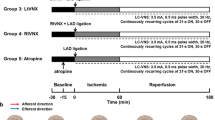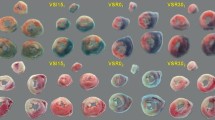Abstract
In a previous research, we described that vagal stimulation increases the infarct size by sympathetic co-activation. The aim of this study was to determine if hemodynamic changes secondary to the vagal stimulation are able to activate sympathetic compensatory neural reflexes, responsible for increasing the infarct size. A second goal was to determine if intermittent vagal stimulation avoids sympathetic activation and reduces infarct size by muscarinic activation of the Akt/glycogen synthase kinase 3 β (GSK-3β) pathway. Rabbits were subjected to 30 min of regional myocardial ischemia and 3 h of reperfusion without vagal stimulation, or the following protocols of right vagus nerve stimulation for 10 min before ischemia: (a) continuous vagal stimulation and (b) intermittent vagal stimulation (cycles of 10 s ON/50 s OFF). Continuous vagal stimulation increased the infarct size (70.7 ± 4.3 %), even after right vagal section (68.6 ± 4.1 %) compared with control group (52.0 ± 3.7 %, p < 0.05). Bilateral vagotomy, pacing, and esmolol abolished the deleterious effect, reaching an infarct size of 43.3 ± 5.1, 43.5 ± 2.1, and 46.0 ± 4.6 % (p < 0.05), respectively. Intermittent stimulation reduced the infarct size to 29.8 ± 3.0 % (p < 0.05 vs I/R). This effect was blocked with atropine (50.2 ± 3.6 %, p < 0.05). Continuous vagal stimulation induced bradycardia and increased the loading conditions and wall stretching of the atria. These changes provoked the co-activation reflex of the sympathetic nervous system, observed by the rise in plasmatic catecholamine levels, which increased the infarct size. Sympathetic co-activation was abolished by continuous vagal stimulation with constant heart rate or parasympathetic deafferentation. Intermittent vagal stimulation attenuated the sympathetic tone and reduced the infarct size by the muscarinic activation of the Akt pathway and GSK-3β inhibition. Continuous stimulation only phosphorylated Akt and GSK-3β when esmolol was administered.









Similar content being viewed by others
References
Buchholz B, Donato M, Perez V, Ivalde FC, Hocht C, Buitrago E, Rodriguez M, Gelpi RJ (2012) Preischemic efferent vagal stimulation increases the size of myocardial infarction in rabbits. Role of the sympathetic nervous system. Int J Cardiol 3:490–491. doi:10.1016/j.ijcard.2011.12.082, PMID: 22257691
Buchholz BD, Annunzio V, Giani JF, Siachoque N, Dominici FP, Turyn D, Perez V, Donato M, Gelpi RJ (2014) Ischemic postconditioning reduces infarct size through the α1-adrenergic receptor pathway. J Cardiovasc Pharmacol 63(6):504–11. doi:10.1097/FJC.0000000000000074, PMID: 24406486
Calvillo L, Vanoli E, Andreoli E, Besana A, Omodeo E, Gnecchi M, Zerbi P, Vago G, Busca G, Schwartz PJ (2011) Vagal stimulation, through its nicotinic action, limits infarct size and the inflammatory response to myocardial ischemia and reperfusion. J Cardiovasc Pharmacol 5:500–507. doi:10.1097/FJC.0b013e31822b7204, PMID: 21765369
Cerati D, Schwartz PJ (1991) Single cardiac vagal fiber activity, acute myocardial ischemia, and risk for sudden death. Circ Res 5:1389–1401, PMID: 1934362
Cohn JN, Levine TB, Olivari MT, Garberg V, Lura D, Francis GS, Simon AB, Rector T (1984) Plasma norepinephrine as a guide to prognosis in patients with chronic congestive heart failure. N Engl J Med 13:819–823, PMID: 6382011
Communal C, Singh K, Pimentel DR, Colucci WS (1998) Norepinephrine stimulates apoptosis in adult rat ventricular myocytes by activation of the beta-adrenergic pathway. Circulation 13:1329–1334, PMID: 9751683
Costandi PN, Frank LR, McCulloch AD, Omens JH (2006) Role of diastolic properties in the transition to failure in a mouse model of the cardiac dilatation. Am J Physiol Heart Circ Physiol 6:H2971–H2979, PMID: 16861693
Donato M, Buchholz B, Rodriguez M, Perez V, Inserte J, Garcia-Dorado D, Gelpi RJ (2013) Role of the parasympathetic nervous system in cardioprotection by remote hindlimb ischaemic preconditioning. Exp Physiol 2:425–434. doi:10.1113/expphysiol.2012.066217, PMID: 22872660
Iliodromitis EK, Tasouli A, Andreadou I, Bofilis E, Zoga A, Cokkinos P, Kremastinos DT (2004) Intravenous atenolol and esmolol maintain the protective effect of ischemic preconditioning in vivo. Eur J Pharmacol 499(1–2):163–9, PMID: 15363963
Imai Y, Ito S, Maruta K, Fujita K (1988) Simultaneous determination of catecholamines and serotonin by liquid chromatography, after treatment with boric acid gel. Clin Chem 3:528–530, PMID: 3349603
Jessup M, Brozena S (2003) Heart failure. N Engl J Med 20:2007–2018
Juhaszova M, Zorov DB, Yaniv Y, Nuss HB, Wang S, Sollott SJ (2009) Role of glycogen synthase kinase-3beta in cardioprotection. Circ Res 104(11):1240–52. doi:10.1161/CIRCRESAHA.109.197996, PMID: 19498210
Katare RG, Ando M, Kakinuma Y, Arikawa M, Handa T, Yamasaki F, Sato T (2009) Vagal nerve stimulation prevents reperfusion injury through inhibition of opening of mitochondrial permeability transition pore independent of the bradycardiac effect. J Thorac Cardiovasc Surg 1:223–231. doi:10.1016/j.jtcvs.2008.08.020, PMID: 19154929
Katare RG, Ando M, Kakinuma Y, Arikawa M, Yamasaki F, Sato T (2010) Differential regulation of TNF receptors by vagal nerve stimulation protects heart against acute ischemic injury. J Mol Cell Cardiol 2:234–244. doi:10.1016/j.yjmcc.2010.03.007, PMID: 20302876
Kawada T, Akiyama T, Shimizu S, Kamiya A, Uemura K, Li M, Shirai M, Sugimachi M (2009) Detection of endogenous acetylcholine release during brief ischemia in the rabbit ventricle: a possible trigger for ischemic preconditioning. Life Sci 15–16:597–601. doi:10.1016/j.lfs.2009.08.015, PMID: 19733187
Koizumi K, Nishino H, Brooks CM (1977) Centers involved in the autonomic reflex reactions originating from stretching of the atria. Proc Natl Acad Sci U S A 5:2177–2181, PMID: 266737
Krieg T, Qin Q, McIntosh EC, Cohen MV, Downey JM (2002) ACh and adenosine activate PI3-kinase in rabbit hearts through transactivation of receptor tyrosine kinases. Am J Physiol Heart Circ Physiol 283(6):H2322–30, PMID: 12388234
Li M, Zheng C, Sato T, Kawada T, Sugimachi M, Sunagawa K (2004) Vagal nerve stimulation markedly improves long-term survival after chronic heart failure in rats. Circulation 1:120–124, PMID: 14662714
Linden RJ, Mary DA, Weatherill D (1982) The nature of the atrial receptors responsible for a reflex increase in activity in efferent cardiac sympathetic nerves. Q J Exp Physiol 1:143–149, PMID: 6281844
Longhurst JC (1984) Cardiac receptors: their function in health and disease. Prog Cardiovasc Dis 3:201–222, PMID: 6387803
Mastitskaya S, Marina N, Gourine A, Gilbey MP, Spyer KM, Teschemacher AG, Kasparov S, Trapp S, Ackland GL, Gourine AV (2012) Cardioprotection evoked by remote ischaemic preconditioning is critically dependent on the activity of vagal pre-ganglionic neurones. Cardiovasc Res 4:487–494. doi:10.1093/cvr/cvs212, PMID: 22739118
McLean BA, Kienesberger PC, Wang W, Masson G, Zhabyeyev P, Dyck JR, Oudit GY (2013) Enhanced recovery from ischemia-reperfusion injury in PI3Kα dominant negative hearts: investigating the role of alternate PI3K isoforms, increased glucose oxidation and MAPK signaling. J Mol Cell Cardiol 54:9–18. doi:10.1016/j.yjmcc.2012.10.015, PMID: 23142539
Mioni C, Bazzani C, Giuliani D, Altavilla D, Leone S, Ferrari A, Minutoli L, Bitto A, Marini H, Zaffe D, Botticelli AR, Iannone A, Tomasi A, Bigiani A, Bertolini A, Squadrito F, Guarini S (2005) Activation of an efferent cholinergic pathway produces strong protection against myocardial ischemia/reperfusion injury in rats. Crit Care Med 11:2621–2628, PMID: 16276189
Olea FD, De Lorenzi A, Cortes C, Cuniberti L, Fazzi L, Mdel Flamenco P, Locatelli P, Cabeza Meckert P, Bercovich A, Laguens R, Crottogini A (2013) Combined VEGF gene transfer and erythropoietin in ovine reperfused myocardial infarction. Int J Cardiol 2:291–298. doi:10.1016/j.ijcard.2011.08.078, PMID: 21944383
Paintal AS (1973) Vagal sensory receptors and their reflex effects. Physiol Rev 1:159–227, PMID: 4568412
Qin Q, Downey JM, Cohen MV (2003) Acetylcholine but not adenosine triggers preconditioning through PI3-kinase and a tyrosine kinase. Am J Physiol Heart Circ Physiol 284(2):H727–34, PMID: 12388236
Recordati G, Lombardi F, Bishop VS, Malliani A (1975) Response of type B atrial vagal receptors to changes in wall tension during atrial filling. Circ Res 6:682–691, PMID: 1132063
Recordati G, Lombardi F, Bishop VS, Malliani A (1976) Mechanical stimuli exciting type A atrial vagal receptors in the cat. Circ Res 5:397–403, PMID: 1269079
Schaller B, Cornelius JF, Sandu N, Ottaviani G, Perez-Pinzon MA (2009)Oxygen-conserving reflexes of the brain: the current molecular knowledge. J Cell Mol Med 4:644–647. doi:10.1111/j.1582-4934.2009.00659.x, PMID: 19438971
Schwartz PJ, La Rovere MT, Vanoli E (1992) Autonomic nervous system and sudden cardiac death. Experimental basis and clinical observations for post-myocardial infarction risk stratification. Circulation 1(Suppl):I77–I91, PMID: 1728509
Schwartz PJ, De Ferrari GM, Sanzo A, Landolina M, Rordorf R, Raineri C, Campana C, Revera M, Ajmone-Marsan N, Tavazzi L, Odero A (2008) Long term vagal stimulation in patients with advanced heart failure: first experience in man. Eur J Heart Fail 9:884–891. doi:10.1016/j.ejheart.2008.07.016, PMID: 18760668
Terashima Y, Sato T, Yano T, Maas O, Itoh T, Miki T, Tanno M, Kuno A, Shimamoto K, Miura T (2010) Roles of phospho-GSK-3β in myocardial protection afforded by activation of the mitochondrial K ATP channel. J Mol Cell Cardiol 49:762–70. doi:10.1016/j.yjmcc.2010.08.001, PMID: 20692265
Tong H, Imahashi K, Steenbergen C, Murphy E (2002) Phosphorylation of glycogen synthase kinase-3beta during preconditioning through a phosphatidylinositol-3-kinase-dependent pathway is cardioprotective. Circ Res 90:377–379, PMID: 11884365
Tsutsumi T, Ide T, Yamato M, Kudou W, Andou M, Hirooka Y, Utsumi H, Tsutsui H, Sunagawa K (2008) Modulation of the myocardial redox state by vagal nerve stimulation after experimental myocardial infarction. Cardiovasc Res 4:713–721, PMID: 18065771
Uemura K, Li M, Tsutsumi T, Yamazaki T, Kawada T, Kamiya A, Inagaki M, Sunagawa K, Sugimachi M (2007) Efferent vagal nerve stimulation induces tissue inhibitor of metalloproteinase-1 in myocardial ischemia-reperfusion injury in rabbit. Am J Physiol Heart Circ Physiol 4:H2254–H2261, PMID: 17693545
Uemura K, Zheng C, Li M, Kawada T, Sugimachi M (2010) Early short-term vagal nerve stimulation attenuates cardiac remodeling after reperfused myocardial infarction. J Card Fail 8:689–699. doi:10.1016/j.cardfail.2010.03.001, PMID: 20670848
Wahab NS, Zucker IH, Gilmore JP (1975) Lack of a direct effect of efferent cardiac vagal nerve activity on atrial receptor activity. Am J Physiol 2:314–317, PMID: 1163659
Zhai P, Sciarretta S, Galeotti J, Volpe M, Sadoshima J (2011) Differential roles of GSK-3β during myocardial ischemia and ischemia/reperfusion. Circ Res 109:502–511. doi:10.1161/CIRCRESAHA.111.249532, PMID: 21737790
Zhan DY, Du CK, Akiyama T, Sonobe T, Tsuchimochi H, Shimizu S, Kawada T, Shirai M (2013) In vivo monitoring of acetylcholine release from cardiac vagal nerve endings in anesthetized mice. Auton Neurosci 1–2:91–94. doi:10.1016/j.autneu.2013.02.014, PMID: 23499513
Acknowledgments
This work was supported by a research grant from National Agency for Scientific and Technological Promotion (ANPCyT, PICT 01071), the University of Buenos Aires (UBACyT M032), the National Council of Scientific and Technological Research (CONICET) (PIP0197/2011), and the Argentine Society of Cardiology.
Ethical standards
The procedures used in this study were approved by the Animal Care and Research Committee of the University of Buenos Aires (Protocol # 2004/11) and were in compliance with the Guide for the Care and Use of Laboratory Animals published by the US National Institutes of Health (NIH publication, Eight edition; 2010).
Conflict of interest
The authors declare that they have no conflict of interest.
Author information
Authors and Affiliations
Corresponding author
Additional information
Bruno Buchholz and Martín Donato contributed equally to this work.
Rights and permissions
About this article
Cite this article
Buchholz, B., Donato, M., Perez, V. et al. Changes in the loading conditions induced by vagal stimulation modify the myocardial infarct size through sympathetic-parasympathetic interactions. Pflugers Arch - Eur J Physiol 467, 1509–1522 (2015). https://doi.org/10.1007/s00424-014-1591-2
Received:
Revised:
Accepted:
Published:
Issue Date:
DOI: https://doi.org/10.1007/s00424-014-1591-2




